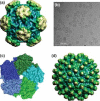Viral nanoparticles and virus-like particles: platforms for contemporary vaccine design
- PMID: 20872839
- PMCID: PMC7169818
- DOI: 10.1002/wnan.119
Viral nanoparticles and virus-like particles: platforms for contemporary vaccine design
Abstract
Current vaccines that provide protection against infectious diseases have primarily relied on attenuated or inactivated pathogens. Virus-like particles (VLPs), comprised of capsid proteins that can initiate an immune response but do not include the genetic material required for replication, promote immunogenicity and have been developed and approved as vaccines in some cases. In addition, many of these VLPs can be used as molecular platforms for genetic fusion or chemical attachment of heterologous antigenic epitopes. This approach has been shown to provide protective immunity against the foreign epitopes in many cases. A variety of VLPs and virus-based nanoparticles are being developed for use as vaccines and epitope platforms. These particles have the potential to increase efficacy of current vaccines as well as treat diseases for which no effective vaccines are available.
Copyright © 2010 John Wiley & Sons, Inc.
Figures



Similar articles
-
Genetic Modifications of Icosahedral Plant Virus-based Nanoparticles for Vaccine and Immunotherapy Applications.Curr Protein Pept Sci. 2017 Aug 30;18(11):1141-1151. doi: 10.2174/1389203718666170424153109. Curr Protein Pept Sci. 2017. PMID: 28440187 Review.
-
Peptide presentation on primate erythroparvovirus 1 virus-like particles: In vitro assembly, stability and immunological properties.Virus Res. 2016 Sep 15;224:12-8. doi: 10.1016/j.virusres.2016.08.007. Epub 2016 Aug 11. Virus Res. 2016. PMID: 27523978
-
The coming of age of virus-like particle vaccines.Biol Chem. 2008 May;389(5):521-36. doi: 10.1515/bc.2008.064. Biol Chem. 2008. PMID: 18953718 Review.
-
Advancements in protein nanoparticle vaccine platforms to combat infectious disease.Wiley Interdiscip Rev Nanomed Nanobiotechnol. 2021 May;13(3):e1681. doi: 10.1002/wnan.1681. Epub 2020 Nov 8. Wiley Interdiscip Rev Nanomed Nanobiotechnol. 2021. PMID: 33164326 Free PMC article. Review.
-
Virus-like particles as a vaccine delivery system: myths and facts.Hum Vaccin. 2008 Jan-Feb;4(1):5-12. doi: 10.4161/hv.4.1.5559. Epub 2008 Jan 11. Hum Vaccin. 2008. PMID: 18438104 Review.
Cited by
-
Rabbit hemorrhagic disease virus capsid, a versatile platform for foreign B-cell epitope display inducing protective humoral immune responses.Sci Rep. 2016 Aug 23;6:31844. doi: 10.1038/srep31844. Sci Rep. 2016. PMID: 27549017 Free PMC article.
-
Mitochondrion: A Promising Target for Nanoparticle-Based Vaccine Delivery Systems.Vaccines (Basel). 2016 Jun 1;4(2):18. doi: 10.3390/vaccines4020018. Vaccines (Basel). 2016. PMID: 27258316 Free PMC article. Review.
-
Virus-like particles: the new frontier of vaccines for animal viral infections.Vet Immunol Immunopathol. 2012 Aug 15;148(3-4):211-25. doi: 10.1016/j.vetimm.2012.04.026. Epub 2012 Jun 1. Vet Immunol Immunopathol. 2012. PMID: 22705417 Free PMC article. Review.
-
Improved Production Efficiency of Virus-Like Particles by the Baculovirus Expression Vector System.PLoS One. 2015 Oct 12;10(10):e0140039. doi: 10.1371/journal.pone.0140039. eCollection 2015. PLoS One. 2015. PMID: 26458221 Free PMC article.
-
Nanotheranostics against COVID-19: From multivalent to immune-targeted materials.J Control Release. 2020 Dec 10;328:112-126. doi: 10.1016/j.jconrel.2020.08.060. Epub 2020 Aug 31. J Control Release. 2020. PMID: 32882269 Free PMC article. Review.
References
-
- Frazer IH, Lowy DR, Schiller JT. Prevention of cancer through immunization: prospects and challenges for the 21st century. Eur J Immunol 2007, 37(suppl 1):S148–S155. doi:10.1002/eji.200737820. - PubMed
-
- Hornef MW, Wick MJ, Rhen M, Normark S. Bacterial strategies forovercoming host innate and adaptive immune responses. Nat Immunol 2002, 3:1033–1040. doi:10.1038/ni1102‐1033ni1102‐1033 [pii]. - PubMed
-
- Barton GM, Medzhitov R. Toll‐like receptors and their ligands. CurrTop Microbiol Immunol 2002, 270:81–92. - PubMed
-
- Starr TK, Jameson SC, Hogquist KA. Positive and negative selection ofT cells. Annu Rev Immunol 2003, 21:139–176. doi:10.1146/annurev.immunol.21.120601.141107120601.141107[pii]. - PubMed
Publication types
MeSH terms
Substances
LinkOut - more resources
Full Text Sources
Other Literature Sources

